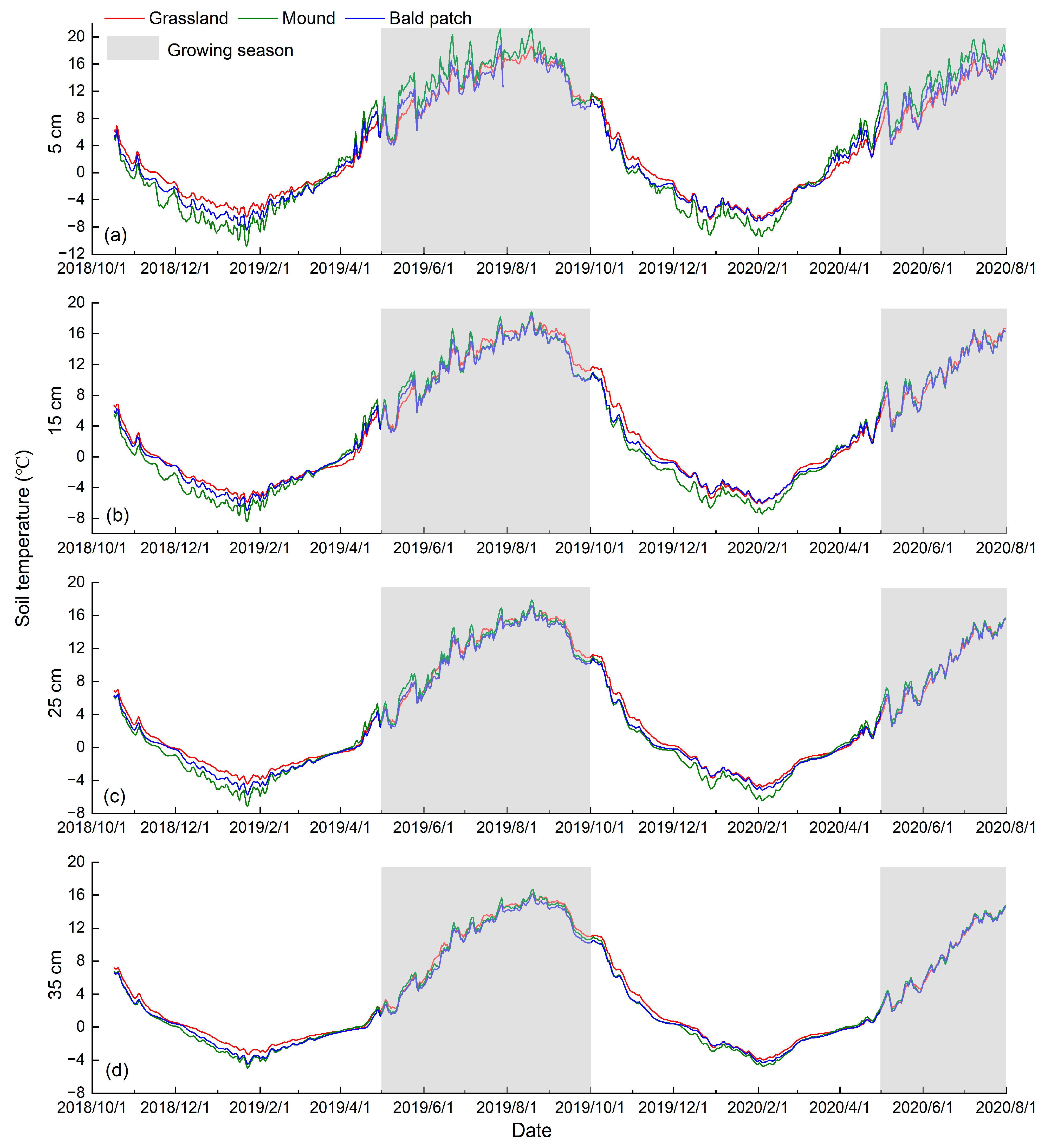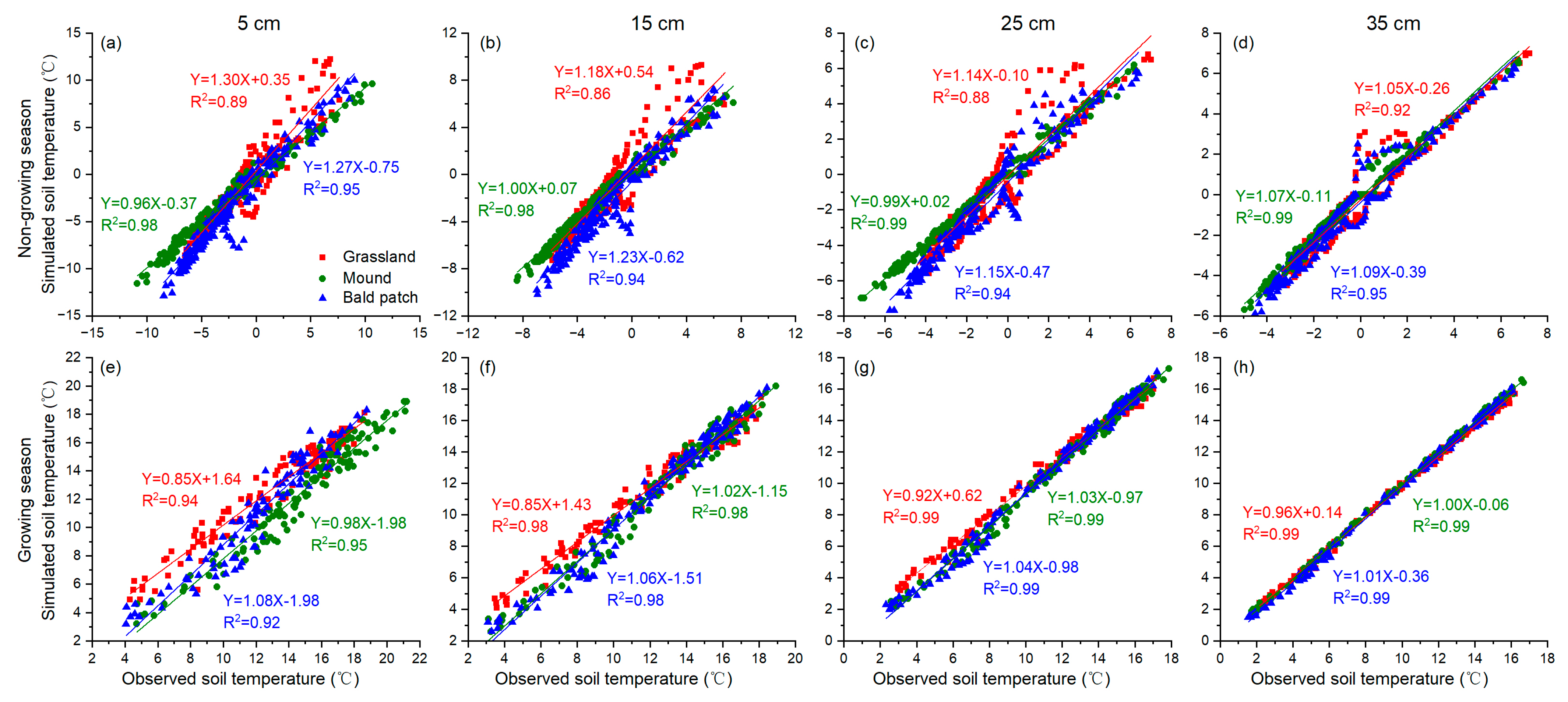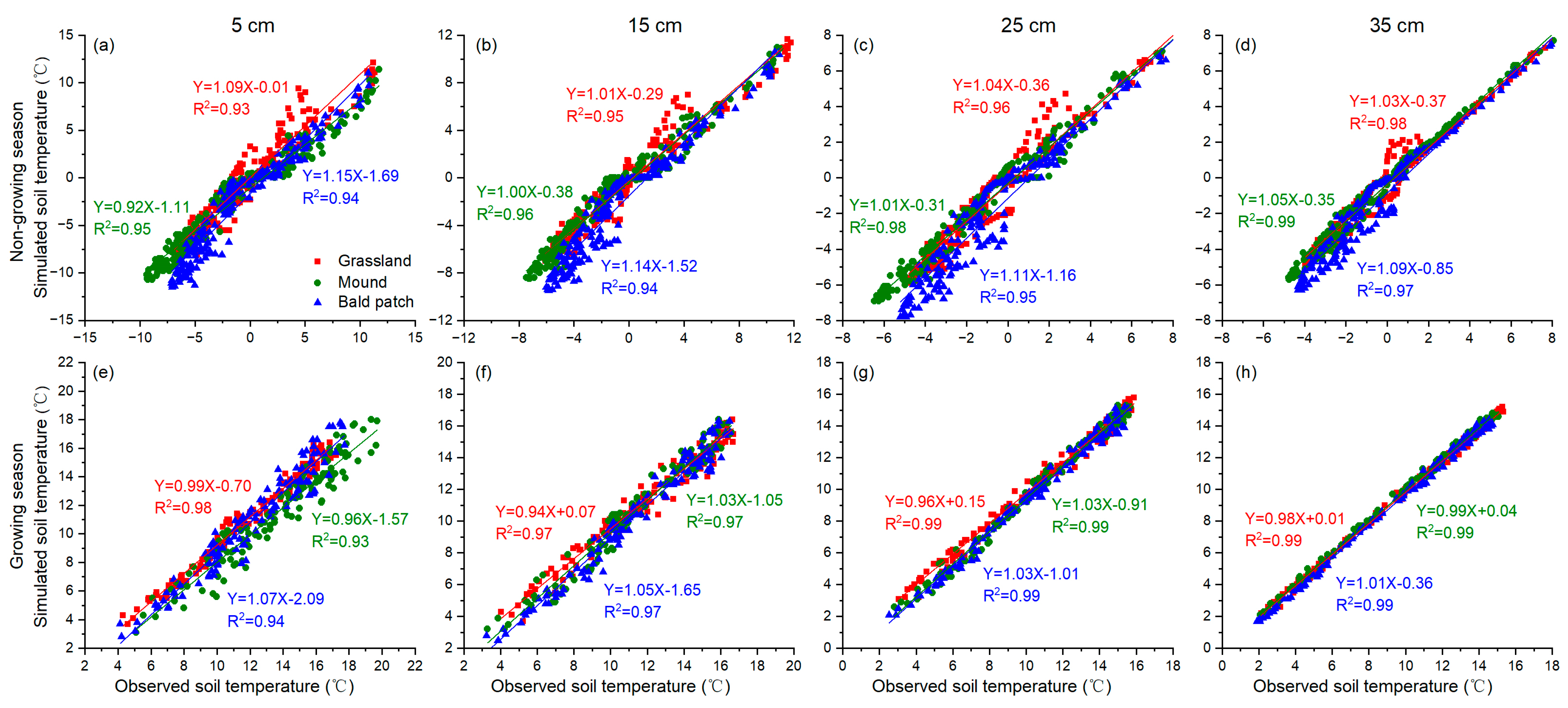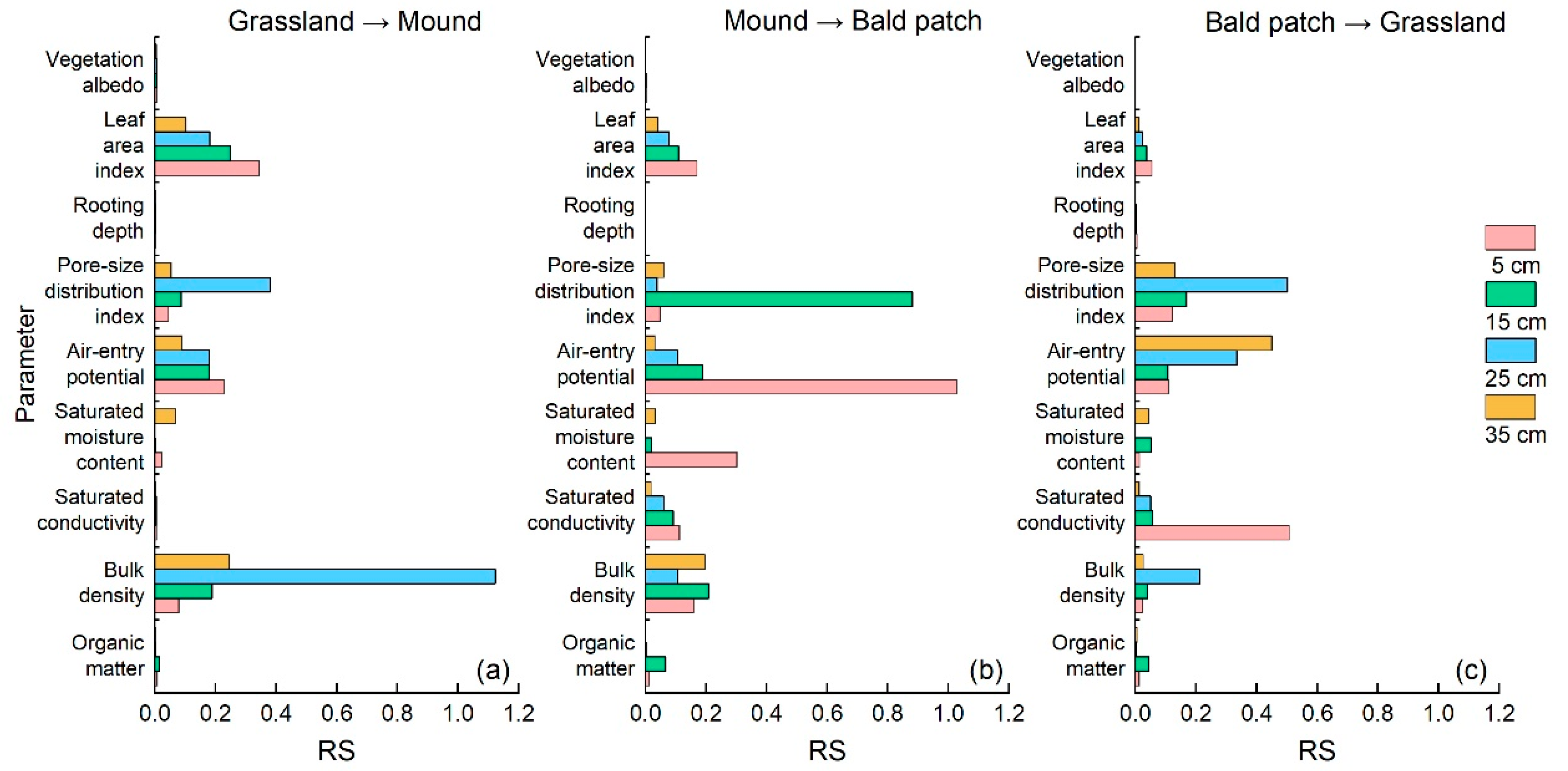Simulation of Soil Temperature under Plateau Zokor’s (Eospalax baileyi) Disturbance in the Qinghai Lake Watershed, Northeast Qinghai–Tibet Plateau
Abstract
:Simple Summary
Abstract
1. Introduction
2. Materials and Methods
2.1. Study Area
2.2. Experiment Design
2.3. Model Description
2.4. Data Analysis
3. Results
3.1. Variation of Measured Soil Temperature
3.2. Simulation of Soil Temperature
3.3. Sensitivity of Soil Temperature Change
4. Discussion
4.1. Reasons for Soil Temperature Difference under Disturbance
4.2. Applicability of SHAW Model under Disturbance
4.3. Effects of Soil and Vegetation Parameters on Soil Temperature
5. Conclusions
Author Contributions
Funding
Institutional Review Board Statement
Informed Consent Statement
Data Availability Statement
Acknowledgments
Conflicts of Interest
References
- Liu, J.; Milne, R.I.; Cadotte, M.W.; Wu, Z.-Y.; Provan, J.; Zhu, G.-F.; Gao, L.-M.; Li, D.-Z. Protect Third Pole’s fragile ecosystem. Science 2018, 362, 1368. [Google Scholar] [CrossRef] [PubMed]
- Ma, X.; Asano, M.; Tamura, K.; Zhao, R.; Nakatsuka, H.; Wang, T. Physicochemical properties and micromorphology of degraded alpine meadow soils in the Eastern Qinghai-Tibet Plateau. Catena 2020, 194, 104649. [Google Scholar] [CrossRef]
- Ma, Y.M.; Hu, Z.Y.; Tian, L.D.; Zhang, F.; Duan, A.M.; Yang, K.; Zhang, Y.L.; Yang, Y.P. Study progresses of the Tibet Plateau climate system change and mechanism of its impact on East Asia. Adv. Earth Sci. 2014, 29, 207–215, (In Chinese with English Abstract). [Google Scholar]
- Gao, Q.; Guo, Y.; Xu, H.; Ganjurjav, H.; Li, Y.; Wan, Y.; Qin, X.; Ma, X.; Liu, S. Climate change and its impacts on vegetation distribution and net primary productivity of the alpine ecosystem in the Qinghai Tibetan Plateau. Sci. Total Environ. 2016, 554–555, 34–41. [Google Scholar] [CrossRef]
- Hou, Y.; Zhao, W.; Liu, Y.; Yang, S.; Hu, X.; Cherubini, F. Relationships of multiple landscape services and their influencing factors on the Qinghai-Tibet Plateau. Landsc. Ecol. 2021, 36, 1987–2005. [Google Scholar] [CrossRef]
- Sun, X.Y.; Zhang, R.J.; Huang, W.; Sun, A.; Lin, L.-J.; Xu, H.-G.; Jiang, D.-C. The response between glacier evolution and eco-geological environment on the Qinghai-Tibet Plateau. China Geol. 2019, 1, 1–7. [Google Scholar] [CrossRef]
- Li, S.; Zhang, H.; Zhou, X.; Yu, H.; Li, W. Enhancing protected areas for biodiversity and ecosystem services in the Qinghai-Tibet Plateau. Ecosyst. Serv. 2020, 43, 101090. [Google Scholar] [CrossRef]
- Zhao, D.S.; Wu, S.H. Projected changes in permafrost active layer thickness over the Qinghai-Tibet Plateau under climate change. Water Resour. Res. 2019, 55, 7860–7875. [Google Scholar] [CrossRef]
- Yu, C.; Li, Y.; Jin, H.; Ma, Q.; Yu, Z.; Shi, K.; Li, X.; Chen, G. Organic versus inorganic carbon exports from glacier and permafrost watersheds in Qinghai-Tibet Plateau. Aquat. Geochem. 2021, 27, 283–296. [Google Scholar] [CrossRef]
- Lehnert, L.W.; Wesche, K.; Trachte, K.; Reudenbach, C.; Bendix, J. Climate variability rather than overstocking causes recent large scale cover changes of Tibetan pastures. Sci. Rep. 2016, 6, 24367. [Google Scholar] [CrossRef]
- Qin, Y.; Wu, T.; Zhao, L.; Wu, X.; Li, R.; Xie, C.; Pang, Q.; Hu, G.; Qiao, Y.; Zhao, G.; et al. Numerical modeling of the active layer thickness and permafrost thermal state across Qinghai-Tibetan Plateau. J. Geophys. Res. Atmos. 2017, 122, 11604–11620. [Google Scholar] [CrossRef]
- Yu, H.; Ding, Q.; Meng, B.; Lv, Y.; Liu, C.; Zhang, X.; Sun, Y.; Li, M.; Yi, S. The relative contributions of climate and grazing on the dynamics of grassland NPP and PUE on the Qinghai-Tibet Plateau. Remote Sens. 2021, 13, 3424. [Google Scholar] [CrossRef]
- Hu, H.; Wang, G.; Liu, G.; Li, T.; Ren, D.; Wang, Y.; Cheng, H.; Wang, J. Influences of alpine ecosystem degradation on soil temperature in the freezing-thawing process on Qinghai-Tibet Plateau. Environ. Geol. 2009, 57, 1391–1397. [Google Scholar] [CrossRef]
- Harris, R.B. Rangeland degradation on the Qinghai-Tibetan plateau: A review of the evidence of its magnitude and causes. J. Arid Environ. 2010, 74, 1–12. [Google Scholar] [CrossRef]
- Yu, C.; Pang, X.P.; Wang, Q.; Jin, S.H.; Shu, C.C.; Guo, Z.G. Soil nutrient changes induced by the presence and intensity of plateau pika (Ochotona curzoniae) disturbances in the Qinghai-Tibet Plateau, China. Ecol. Eng. 2017, 106, 1–9. [Google Scholar] [CrossRef]
- Chu, B.; Ma, S.J.; Zhou, Y.S.; Ji, C.P.; Zhou, J.W.; Zhou, R.; Tian, Y.L.; Hua, L.M. Relationship between the spatial distribution of the mounds of plateau zokor (Eospalax baileyi) and environmental factors in eastern Qilian Mountain. Acta Ecol. Sin. 2018, 38, 964–974, (In Chinese with English Abstract). [Google Scholar]
- Chu, B.; Ye, G.; Yang, S.; Zhou, F.; Zhang, F.; Zhou, J.; Hua, L. Effect of Plateau Zokor (Myospalax fontanierii) disturbance on plant community structure and soil properties in the Eastern Qinghai-Tibet Plateau, China. Rangel. Ecol. Manag. 2020, 73, 520–530. [Google Scholar] [CrossRef]
- Zhao, J.; Tian, L.; Wei, H.; Zhang, T.; Bai, Y.; Li, R.; Tang, Y. Impact of plateau pika (Ochotona curzoniae) burrowing-induced microtopography on ecosystem respiration of the alpine meadow and steppe on the Tibetan plateau. Plant Soil 2021, 458, 217–230. [Google Scholar] [CrossRef]
- Zheng, D.; van der Velde, R.; Su, Z.; Booij, M.J.; Hoekstra, A.Y.; Wen, J. Assessment of roughness length schemes implemented within the Noah Land Surface Model for high-altitude regions. J. Hydrometeorol. 2014, 15, 921–937. [Google Scholar] [CrossRef]
- Meng, F.; Hou, R.; Li, T.; Fu, Q. Variability of soil water heat and energy transfer under different cover conditions in a seasonally frozen soil area. Sustainability 2020, 12, 1782. [Google Scholar] [CrossRef]
- Wu, Q.; Hou, Y.; Yun, H.; Liu, Y. Changes in active-layer thickness and near-surface permafrost between 2002 and 2012 in alpine ecosystems, Qinghai-Xizang (Tibet) Plateau, China. Glob. Planet. Chang. 2015, 124, 149–155. [Google Scholar] [CrossRef]
- Natali, S.M.; Watts, J.D.; Rogers, B.M.; Potter, S.; Ludwig, S.M.; Selbmann, A.-K.; Sullivan, P.F.; Abbott, B.W.; Arndt, K.A.; Birch, L.; et al. Large loss of CO2 in winter observed across the northern permafrost region. Nat. Clim. Chang. 2019, 9, 852–857. [Google Scholar] [CrossRef] [PubMed]
- Yang, S.; Li, R.; Wu, T.; Wu, X.; Zhao, L.; Hu, G.; Zhu, X.; Du, Y.; Xiao, Y.; Zhang, Y.; et al. Evaluation of soil thermal conductivity schemes incorporated into CLM5.0 in permafrost regions on the Tibetan Plateau. Geoderma 2021, 401, 115330. [Google Scholar] [CrossRef]
- Rasmussen, L.H.; Zhang, W.; Hollesen, J.; Cable, S.; Christiansen, H.H.; Jansson, P.-E.; Elberling, B. Modelling present and future permafrost thermal regimes in Northeast Greenland. Cold Reg. Sci. Technol. 2018, 146, 199–213. [Google Scholar] [CrossRef]
- Flerchinger, G.N.; Saxton, K.E. Simultaneous heat and water model of a freezing snow-residue-soil system I. Theory and development. Trans. ASAE 1989, 32, 565–571. [Google Scholar] [CrossRef]
- Yin, Z.F.; Ouyang, H.; Yang, Z.P. Effects of permafrost degradation on soil hydrological processes in alpine steppe on the Qinghai-Tibet plateau. Chin. J. Popul. Resour. Environ. 2012, 10, 54–61. [Google Scholar]
- Guo, L.-M.; Chang, J.; Xu, H.-L.; Sun, W.-J. Modelling plant canopy effects on water-heat exchange in the freezing-thawing processes of active layer on the Qinghai-Tibet Plateau. J. Mt. Sci. 2021, 18, 1564–1579. [Google Scholar] [CrossRef]
- Huai, H.; Wei, W.; Zhang, Y. Characteristics of the Achnatherum splendens community along the Qinghai-Tibet Railway, China. Front. Biol. China 2008, 3, 477–483. [Google Scholar] [CrossRef]
- Walter, K.; Don, A.; Tiemeyer, B.; Freibauer, A. Determining soil bulk density for carbon stock calculations: A systematic method comparison. Soil Sci. Soc. Am. J. 2016, 80, 579–591. [Google Scholar] [CrossRef]
- Beuselinck, L.; Govers, G.; Poesen, J.; Degraer, G.; Froyen, L. Grain-size analysis by laser diffractometry: Comparison with the sieve-pipette method. Catena 1998, 32, 193–208. [Google Scholar] [CrossRef]
- Nelson, D.W.; Sommers, L. A rapid and accurate method for estimating organic carbon in soil. Proc. Indiana Acad. Sci. 1975, 84, 456–462. [Google Scholar]
- Wang, G.X.; Liu, G.S.; Li, C.J.; Yang, Y. The variability of soil thermal and hydrological dynamics with vegetation cover in a permafrost region. Agric. For. Meteorol. 2012, 162–163, 44–57. [Google Scholar]
- Flerchinger, G.N.; Pierson, F.B. Modeling plant canopy effects on variability of soil temperature and water. Agric. For. Meteorol. 1991, 56, 227–246. [Google Scholar] [CrossRef]
- Daniel, C. One-at-a-time plans. J. Am. Stat. Assoc. 1973, 68, 353–360. [Google Scholar] [CrossRef]
- Wilkerson, G.G.; Jones, J.W.; Boote, K.J.; Ingram, K.T.; Mishoe, J.W. Modeling soybean growth for crop management. Trans. ASAE 1983, 26, 63–73. [Google Scholar] [CrossRef]
- Ma, Y.J.; Wu, Y.N.; Liu, W.L.; Li, X.Y.; Lin, H.S. Microclimate response of soil to plateau pika’s disturbance in the northeast Qinghai-Tibet Plateau. Eur. J. Soil Sci. 2018, 69, 232–244. [Google Scholar] [CrossRef]
- Molina-Rode, R.; Wong-Loya, J.A. A new model to predict subsoil-thermal profiles based on seasonal rain conditions and soil properties. Geothermics 2021, 97, 102261. [Google Scholar] [CrossRef]
- Su, J.; Ji, W.; Li, H.; Yao, T.; Wang, J.; Nan, Z. Zokor disturbances indicated positive soil microbial responses with carbon cycle and mineral encrustation in alpine grassland. Ecol. Eng. 2020, 144, 105702. [Google Scholar] [CrossRef]
- Bao, G.S.; Wang, H.S.; Wang, Y.Q.; Zeng, H.; Ma, G.L.; Luo, Z.A.M. Effects of plateau zokor burrowing activity on soil nutrient spatial heterogeneity in alpine grassland. Acta Prataculturae Sin. 2016, 25, 95–104, (In Chinese with English Abstract). [Google Scholar]
- Sun, F.D.; Li, F.; Chen, W.Y.; Zhu, C.; Zhou, S.; Gou, W.L.; Liu, L.; Zhou, J.Q. Seasonal dynamics of soil physicochemical properties, enzyme activity and microbial community of rodents-damaged alpine wetlands by plateau zokor (Myospalax baileyi) in Zogie, southwest China. Acta Ecol. Sin. 2020, 40, 2396–2406, (In Chinese with English Abstract). [Google Scholar]
- Wang, X.; Yue, Y.; Noor, M.A.; Hou, H.; Zhou, B.; Ma, W.; Zhao, M. Tillage time affects soil hydro-thermal properties, seedling growth and yield of maize (Zea mays L.). Appl. Ecol. Environ. Res. 2018, 16, 6007–6023. [Google Scholar] [CrossRef]
- Pang, G.; Chen, D.; Wang, X.; Lai, H.-W. Spatiotemporal variations of land surface albedo and associated influencing factors on the Tibetan Plateau. Sci. Total Environ. 2022, 804, 150100. [Google Scholar] [CrossRef] [PubMed]
- Rowland, J.C.; Travis, B.J.; Wilson, C.J. The role of advective heat transport in talik development beneath lakes and ponds in discontinuous permafrost. Geophys. Res. Lett. 2011, 38, L17504. [Google Scholar] [CrossRef]
- Sjöberg, Y.; Coon, E.; Sannel, A.B.K.; Pannetier, R.; Harp, D.; Frampton, A.; Painter, S.L.; Lyon, S.W. Thermal effects of groundwater flow through subarctic fens: A case study based on field observations and numerical modeling. Water Resour. Res. 2016, 52, 1591–1606. [Google Scholar] [CrossRef]
- Li, R.; Zhao, L.; Wu, T.; Wang, Q.; Ding, Y.; Yao, J.; Wu, X.; Hu, G.; Xiao, Y.; Du, Y.; et al. Soil thermal conductivity and its influencing factors at the Tanggula permafrost region on the Qinghai-Tibet Plateau. Agric. For. Meteorol. 2019, 264, 235–246. [Google Scholar] [CrossRef]
- Lu, J.R.; Zhang, Q.; Li, Y.L.; Tan, Z.Q.; Guo, Y.Y. Impact of typical plant roots on vertical soil water movement in Poyang Lake Wetland: A numerical study. China Environ. Sci. 2020, 40, 2180–2189, (In Chinese with English Abstract). [Google Scholar]
- Lu, J.; Zhang, Q.; Werner, A.D.; Li, Y.; Jiang, S.; Tan, Z. Root-induced changes of soil hydraulic properties-A review. J. Hydrol. 2020, 589, 125203. [Google Scholar] [CrossRef]
- Ajayi, A.E.; Holthusen, D.; Horn, R. Changes in microstructural behaviour and hydraulic functions of biochar amended soils. Soil Tillage Res. 2016, 155, 166–175. [Google Scholar] [CrossRef]
- Fei, Y.; She, D.; Gao, L.; Xin, P. Micro-CT assessment on the soil structure and hydraulic characteristics of saline/sodic soils subjected to short-term amendment. Soil Tillage Res. 2019, 193, 59–70. [Google Scholar] [CrossRef]
- Sasal, M.C.; Andriulo, A.E.; Taboada, M.A. Soil porosity characteristics and water movement under zero tillage in silty soils in Argentinian Pampas. Soil Tillage Res. 2006, 87, 9–18. [Google Scholar] [CrossRef]
- Zhang, W.Z.; Ma, Y.J.; Li, X.Y.; Wang, L. Study on the structural characteristics of plateau zokor tunnels based on ground-penetrating radar. Pratacultural Sci. 2020, 37, 574–582, (In Chinese with English Abstract). [Google Scholar]
- Li, Y.; Shao, M.A.; Wang, W.Y.; Wang, Q.J.; Zhang, J.F.; Lai, J.B. Influence of soil textures on the thermal properties. Trans. CSAE 2003, 19, 62–65, (In Chinese with English Abstract). [Google Scholar]
- Fu, Q.; Ma, Z.A.; Li, T.X.; Jiang, R. Variability of soil temperature under different coverage conditions in alpine region of China. Trans. Chin. Soc. Agric. Mach. 2014, 45, 152–159, (In Chinese with English Abstract). [Google Scholar]





| Land Surface Type | Index | Calibration Period | Validation Period | ||||||
|---|---|---|---|---|---|---|---|---|---|
| 5 cm | 15 cm | 25 cm | 35 cm | 5 cm | 15 cm | 25 cm | 35 cm | ||
| Grassland | R2 | 0.960 | 0.968 | 0.982 | 0.991 | 0.974 | 0.984 | 0.988 | 0.993 |
| RMSE | 1.600 | 1.336 | 0.935 | 0.639 | 1.252 | 0.987 | 0.773 | 0.573 | |
| NSE | 0.958 | 0.968 | 0.980 | 0.989 | 0.971 | 0.981 | 0.985 | 0.991 | |
| Mound | R2 | 0.991 | 0.994 | 0.997 | 0.998 | 0.983 | 0.987 | 0.994 | 0.997 |
| RMSE | 1.646 | 0.780 | 0.531 | 0.321 | 1.902 | 0.969 | 0.665 | 0.463 | |
| NSE | 0.971 | 0.991 | 0.995 | 0.998 | 0.953 | 0.983 | 0.990 | 0.994 | |
| Bald ground | R2 | 0.974 | 0.983 | 0.989 | 0.994 | 0.971 | 0.976 | 0.981 | 0.986 |
| RMSE | 1.880 | 1.409 | 0.969 | 0.642 | 2.342 | 2.116 | 1.779 | 1.333 | |
| NSE | 0.941 | 0.964 | 0.980 | 0.989 | 0.949 | 0.922 | 0.932 | 0.955 | |
Disclaimer/Publisher’s Note: The statements, opinions and data contained in all publications are solely those of the individual author(s) and contributor(s) and not of MDPI and/or the editor(s). MDPI and/or the editor(s) disclaim responsibility for any injury to people or property resulting from any ideas, methods, instructions or products referred to in the content. |
© 2023 by the authors. Licensee MDPI, Basel, Switzerland. This article is an open access article distributed under the terms and conditions of the Creative Commons Attribution (CC BY) license (https://creativecommons.org/licenses/by/4.0/).
Share and Cite
Xie, T.; Ma, Y.-J. Simulation of Soil Temperature under Plateau Zokor’s (Eospalax baileyi) Disturbance in the Qinghai Lake Watershed, Northeast Qinghai–Tibet Plateau. Animals 2023, 13, 2703. https://doi.org/10.3390/ani13172703
Xie T, Ma Y-J. Simulation of Soil Temperature under Plateau Zokor’s (Eospalax baileyi) Disturbance in the Qinghai Lake Watershed, Northeast Qinghai–Tibet Plateau. Animals. 2023; 13(17):2703. https://doi.org/10.3390/ani13172703
Chicago/Turabian StyleXie, Ting, and Yu-Jun Ma. 2023. "Simulation of Soil Temperature under Plateau Zokor’s (Eospalax baileyi) Disturbance in the Qinghai Lake Watershed, Northeast Qinghai–Tibet Plateau" Animals 13, no. 17: 2703. https://doi.org/10.3390/ani13172703






